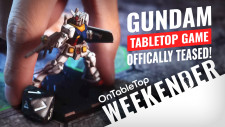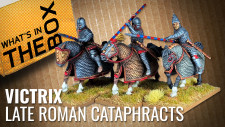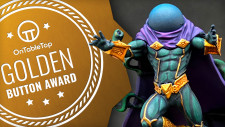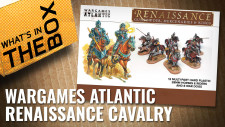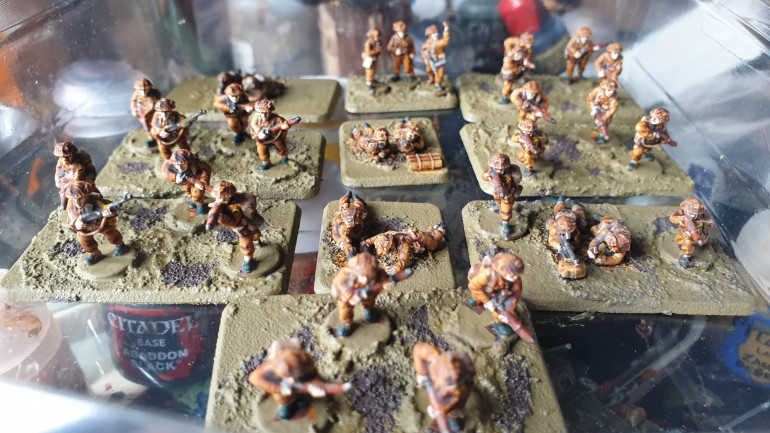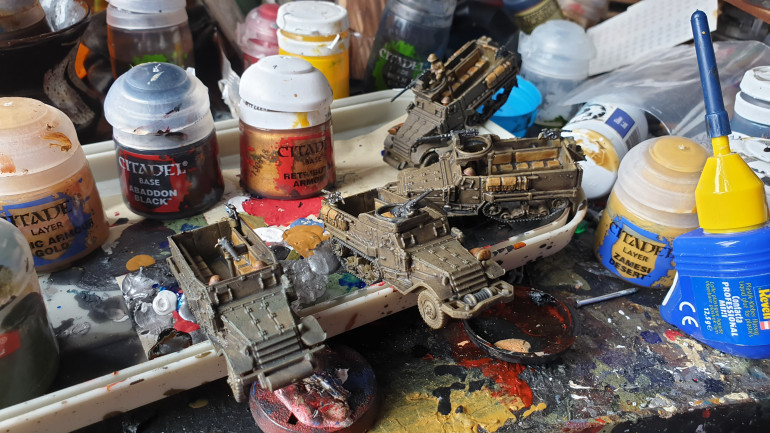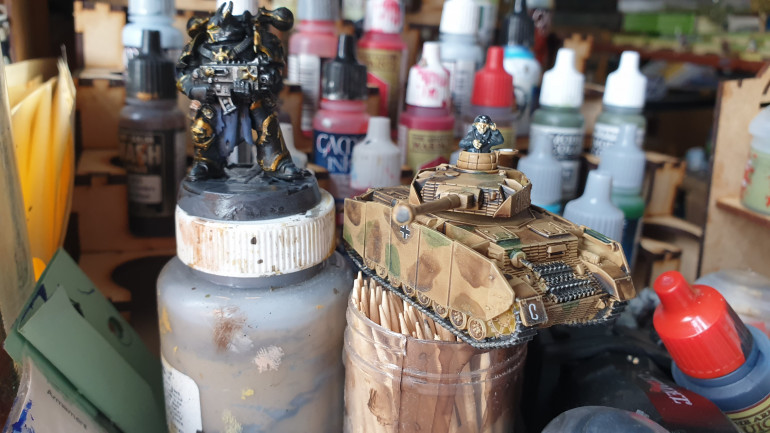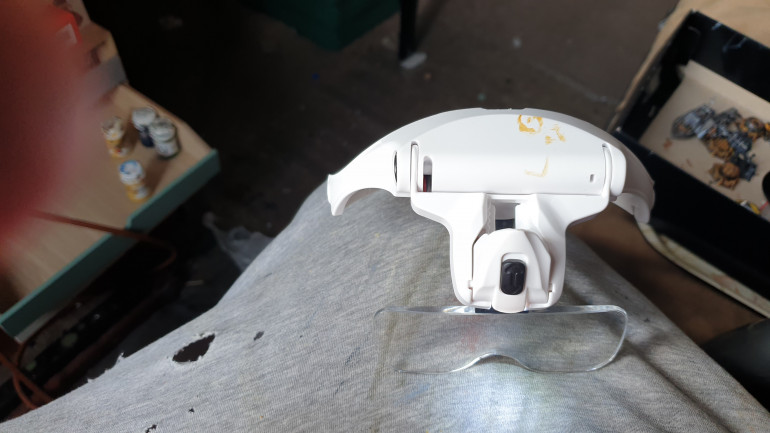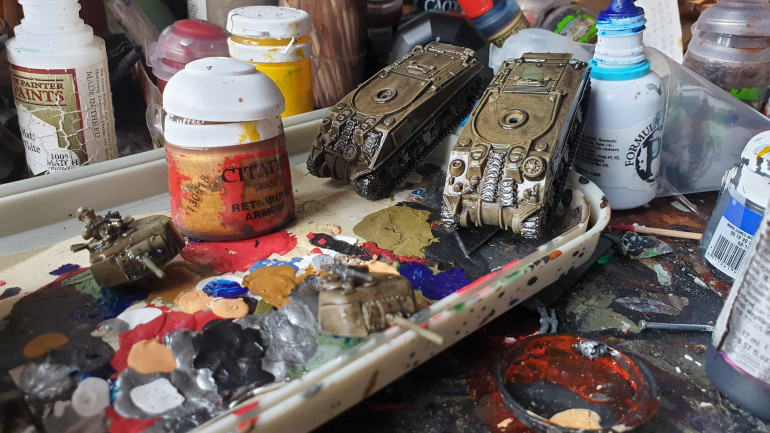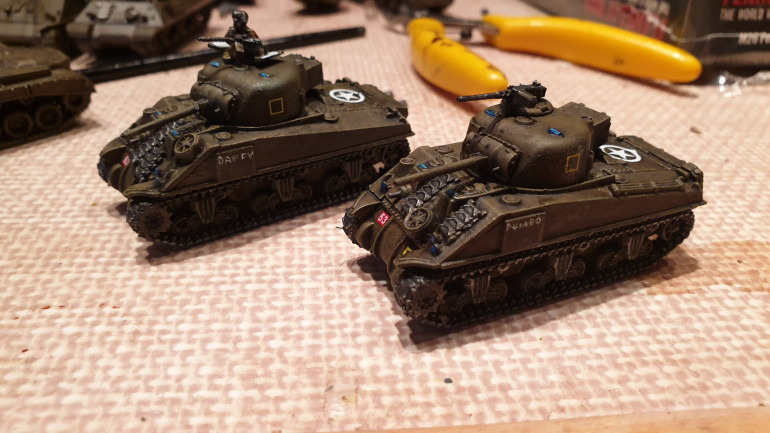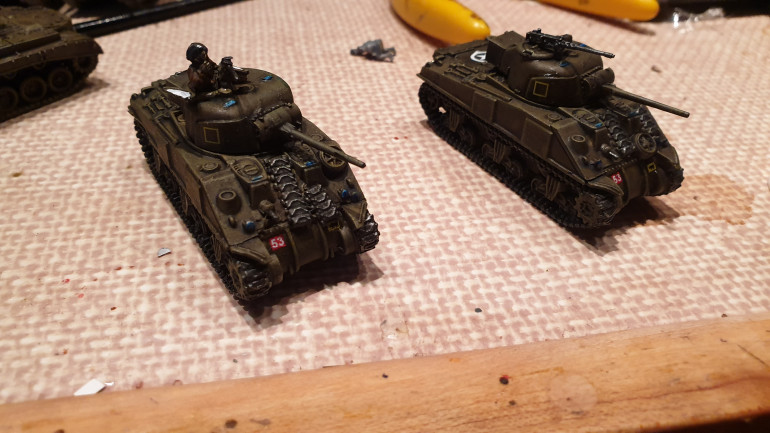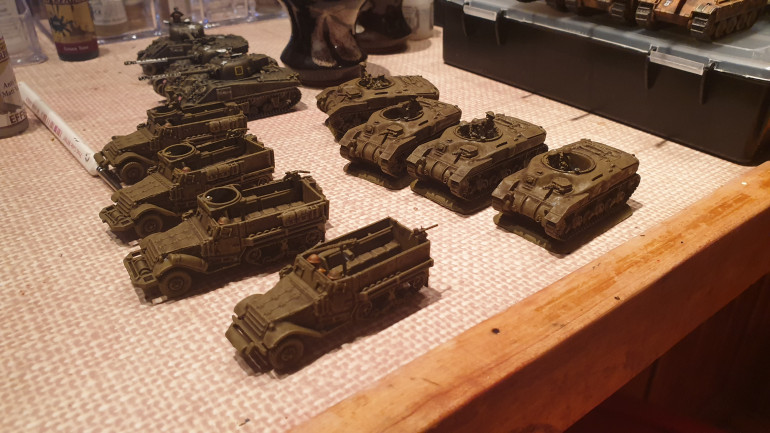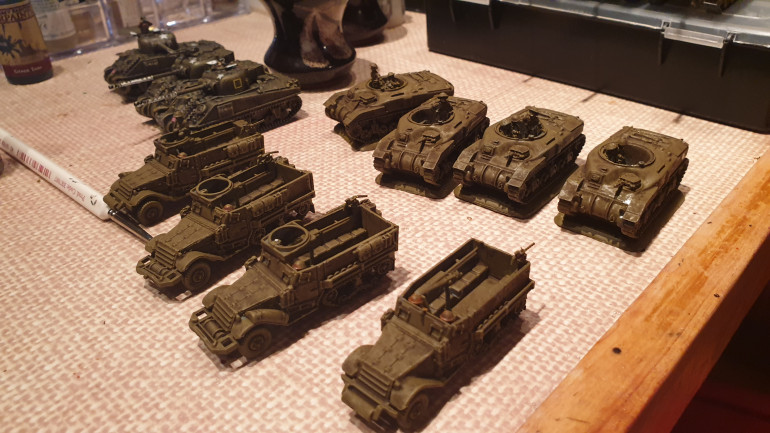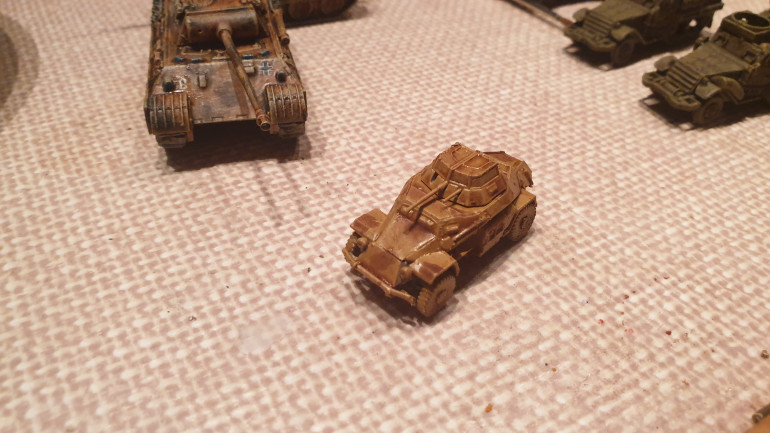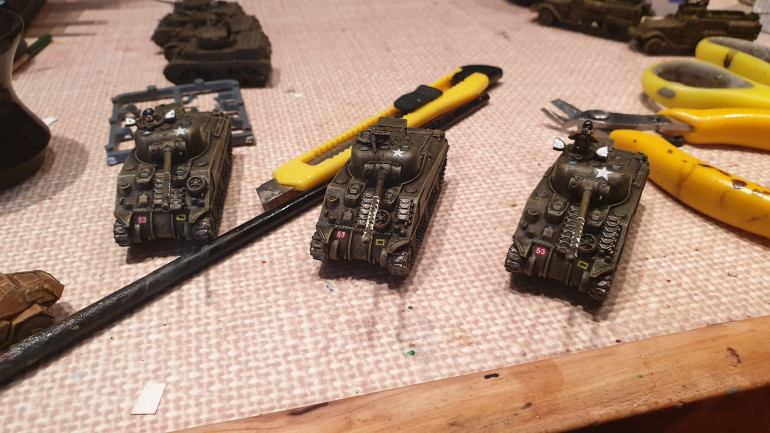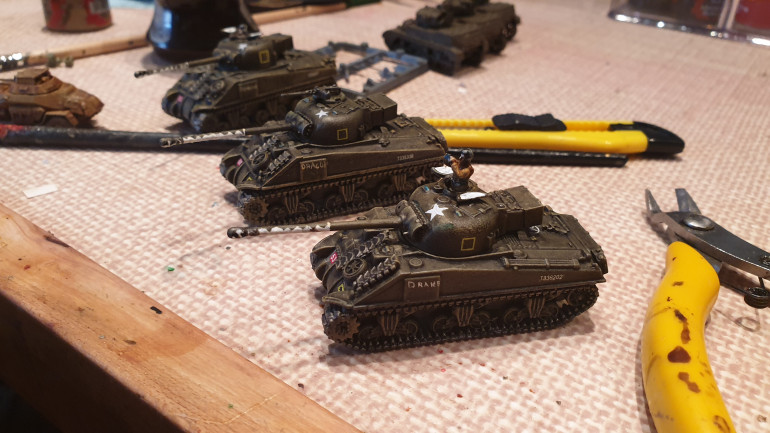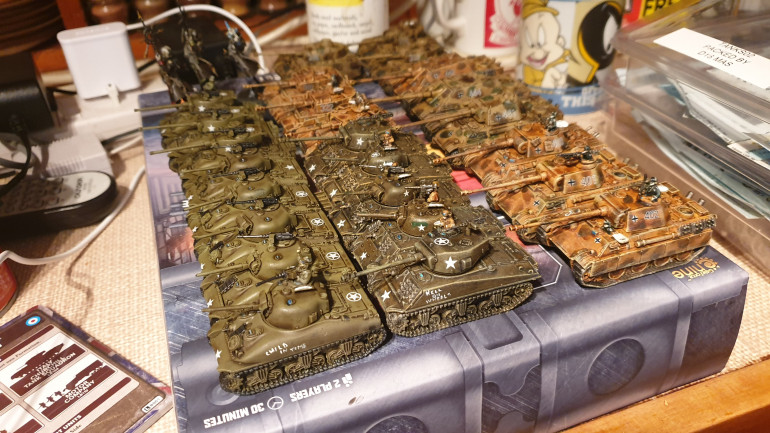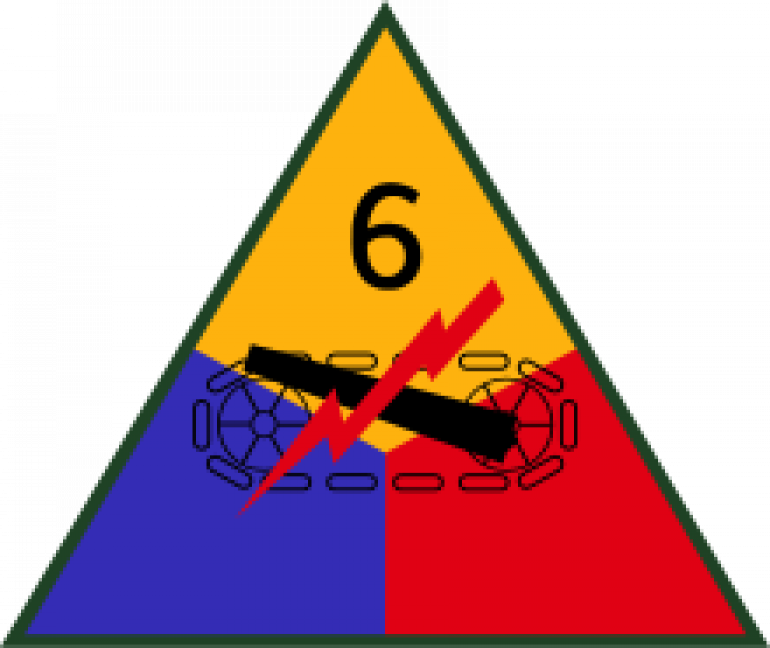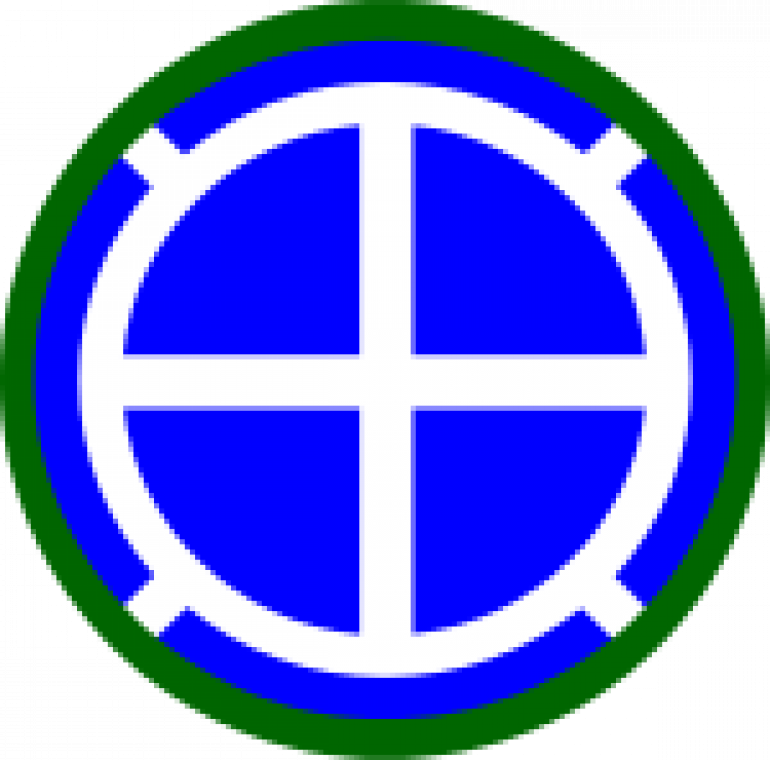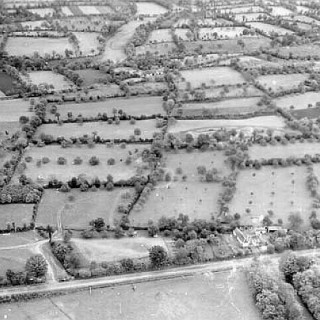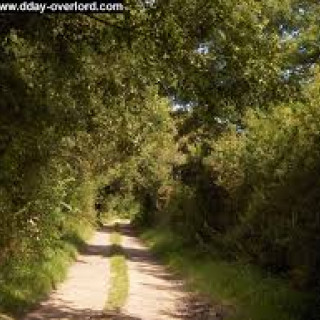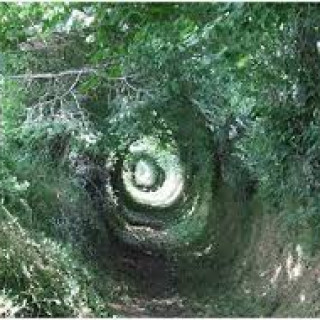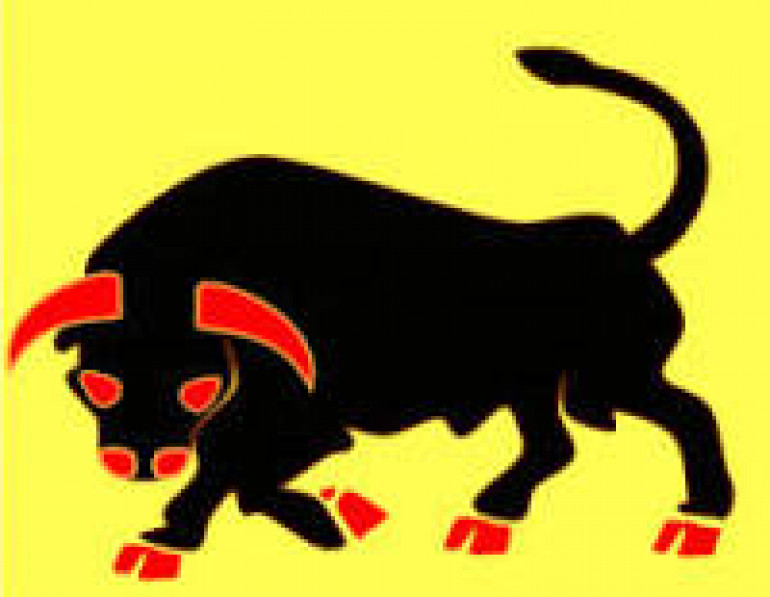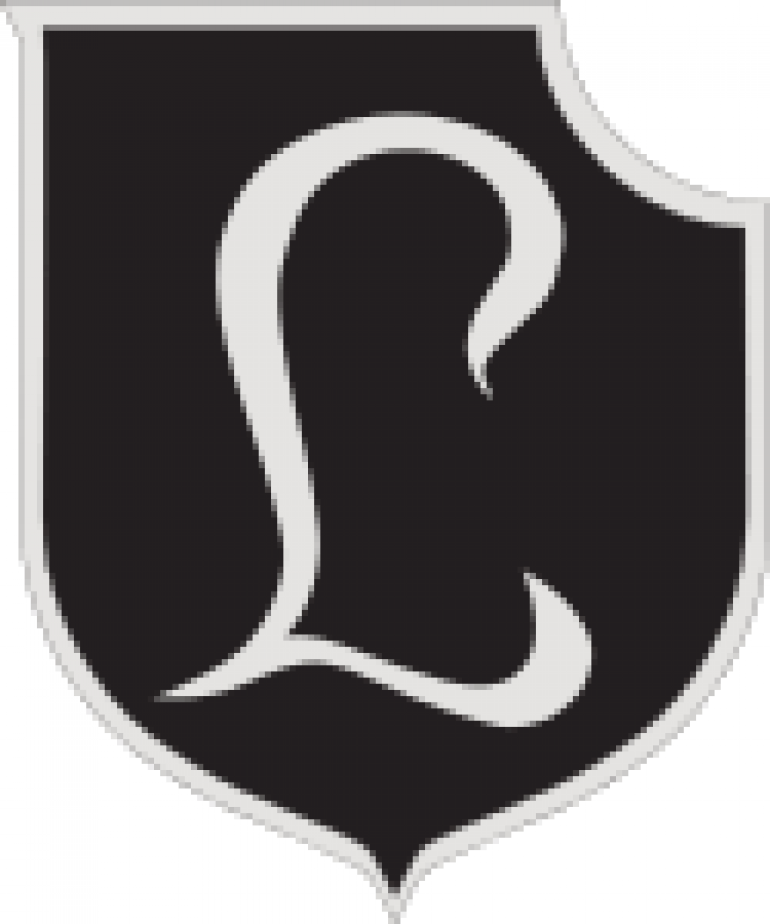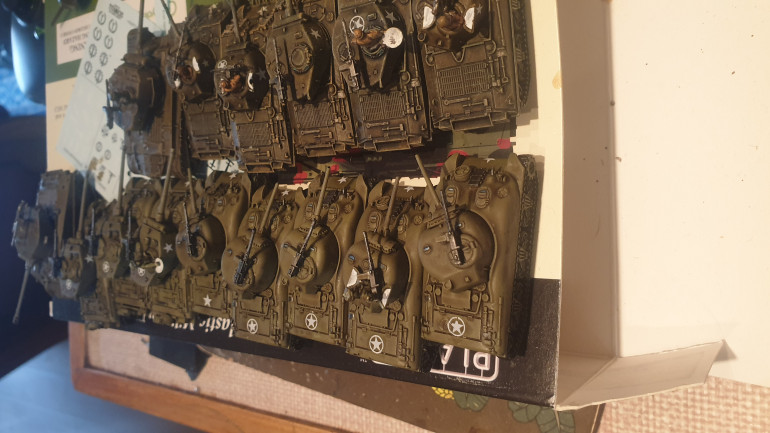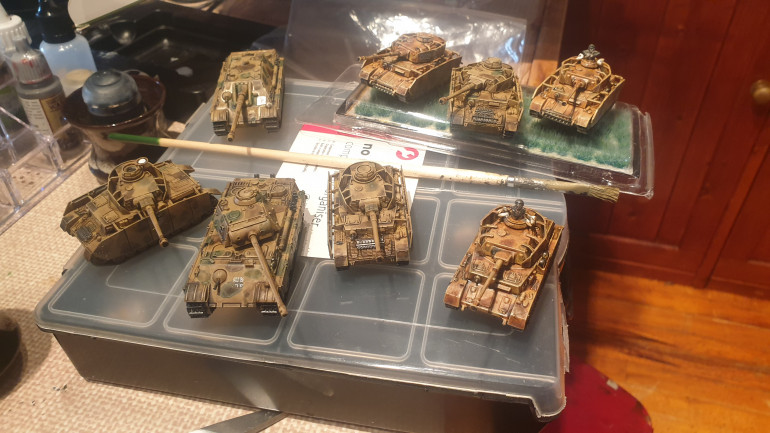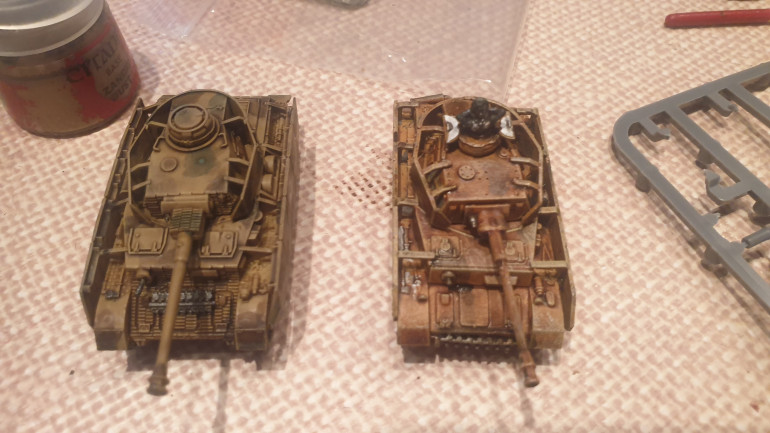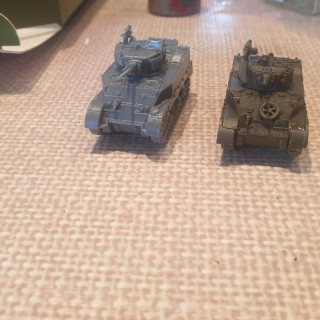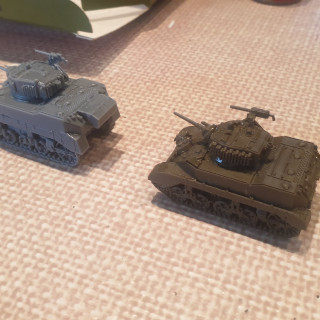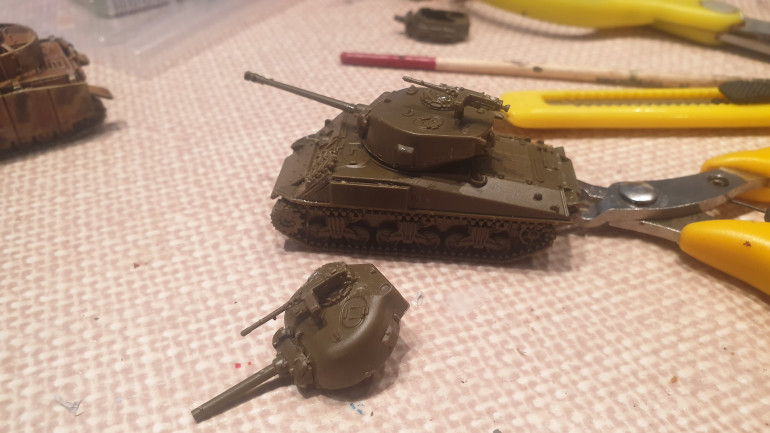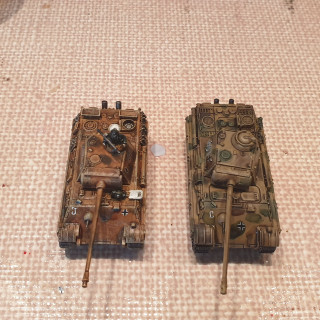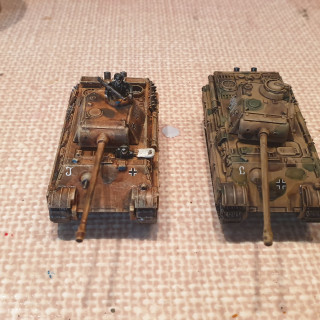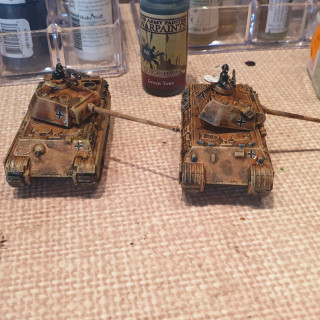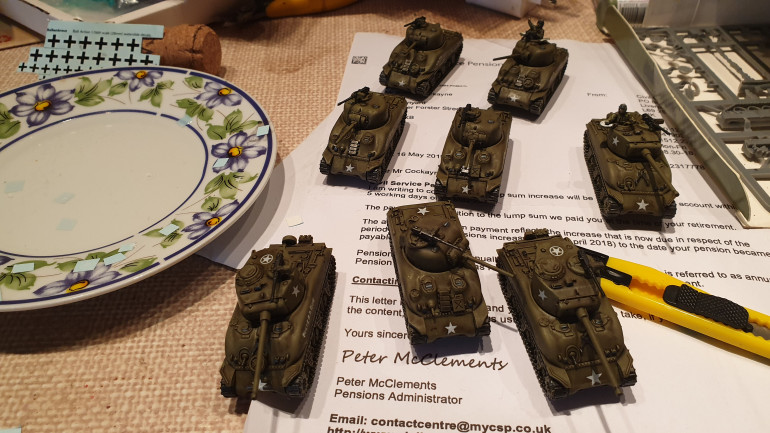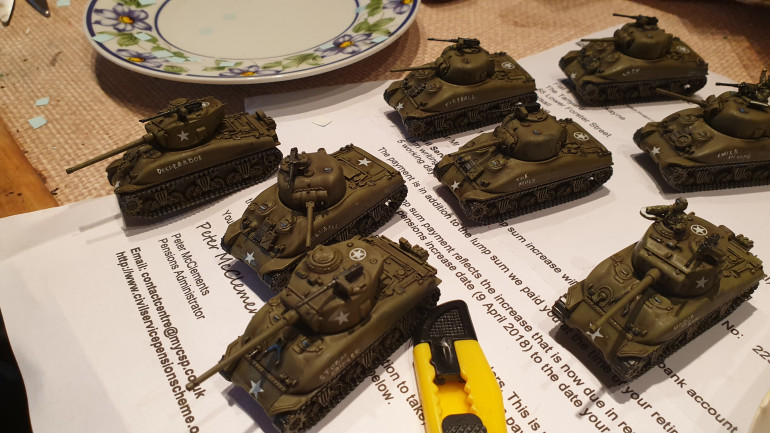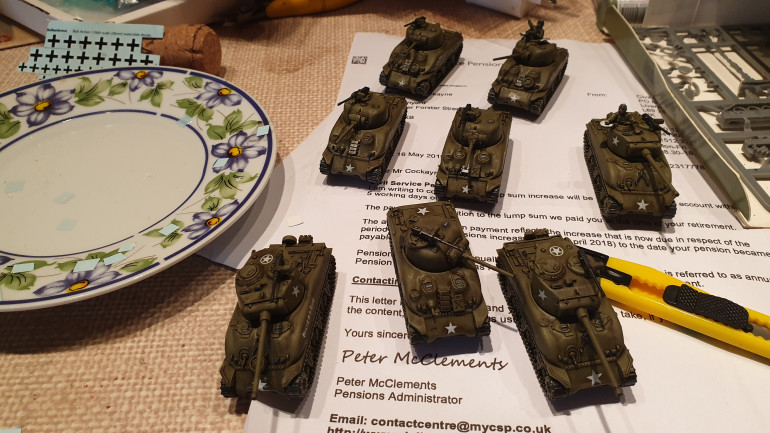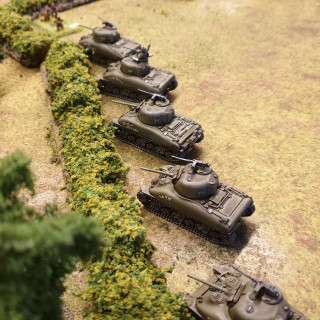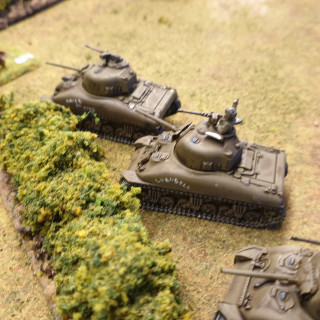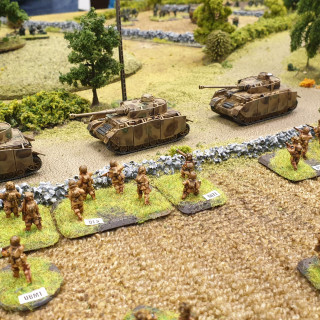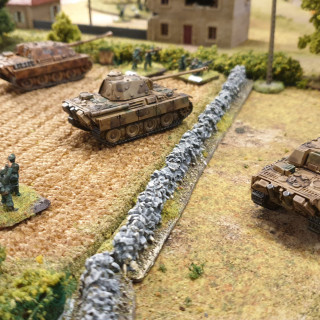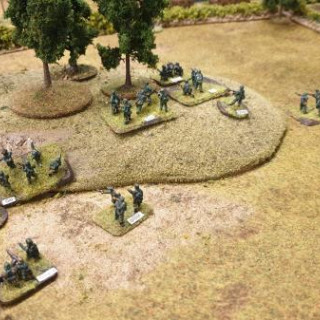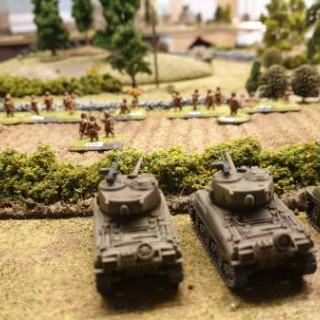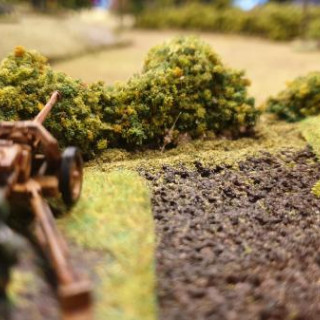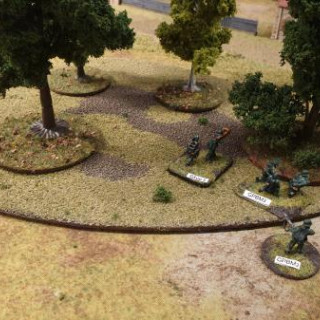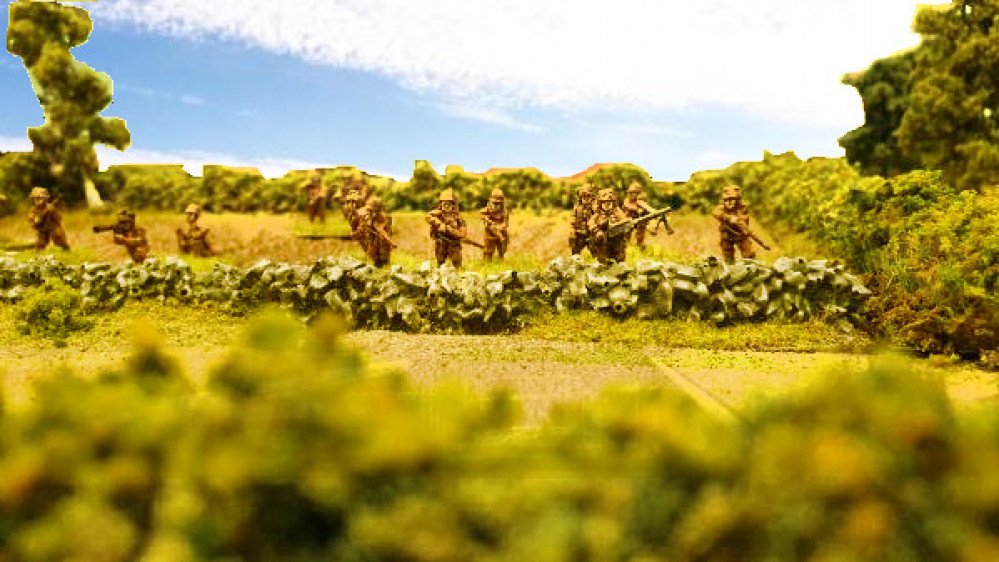
The Road to Falaise Bobs on going 15mm WW2 Adventure
Recommendations: 259
About the Project
The Boot camp is over but not the Buzz, I already had some 15mm units built , some painted , some finished, the usual when other shiney grabbed my attention, the above has brought me back with a bump and this will be one of two projects the other my Fictional WW3 and the revival of partly finished WW2 project that grew from buying the original tanks.
Related Game: Flames of War: The World War II Miniatures Game
Related Company: Battlefront Miniatures
Related Genre: Historical
This Project is Active
Success!!!!
Above British infantry have been sitting 75% done for about 3 years (before I’d heard about Beasts/OTT) and apart from flocking bases are now done, giving me a base Flames of War Rifle Company. This has been bugging me for ages so feel a personal achievement in getting them done.
And and !!
Today I finished the painting of their M5 transports !
I also did the platoon tank commander for by bootcamp Panzer IV’s
This was really helped by the same aide @warzan mentioned on XLBS that bootcamper Jason had for about £12 of Amazon
To add injury to insult , finished two tank commanders for my WW3 project for Challenger 1’s and did more work on finishing a troop of British Shermans
Post weekend update
Due to a domestic problem on the Monday I ended up home a lot earlier than normal, so after some discussion on above was able to get into game room and begin a much needed tidy up after finding all above, but also had time to sit down and finish the Two Sherman’s above, which took way less time than I thought.
I also began adding the decals, now I space putting these on as my ability to put my finger on the one already placed when doing multiples is legendary. So I tend to put one or two , let microsol do its work and then put other on later can take a couple of evenings but way less frustrating.
Summer Clean Continues
I seem to be finding more partly done 15mm , so before I get heavily involved in new units I’m going to continue finishing and sprucing these up in a summer clean as missed the spring one,
Having virtually finished the 3 Fireflys I found now have 4 M5 Halftracks and 4 Rams to do, which will provide transport for the nearly finished British Rifle Platoon and the Platoon in the British Starter Army
I also found a built and primed Skdz 222 from Zveda, I have another one to build, which will go with the Puma to start a recon unit.
Well on top of above I managed last night to completely finish the varnishing of the Bootcamp models post addition of decals , the summer clean nearly finished vehicles including 3 Firefly’s so that above can be worked on over the weekend, including building the other 222 and the Puma to give me a German Recon unit.
U.S Forces
My idea on this has changed a couple of time, The Airborne had to be 101st as my group had been nicknamed the 101st Assault Engineers based on how heavily our group had been tooled up in Call of Cuthlu RPG games and our Battletech Mercenary Regiment which had been the 101st Royal Hussars Striker Regiment in the days of the Star League.
For the armour had originally decided on 746th Tank Battalion and independent tank battalion landed at Normandy , namely as the independents were the 1st units equipped with 76mm Sherman’s as they were the ones initially doing all the fighting .
This meant for infantry I would be going for 9th Infantry Division as above was associated with them, then I remembered we had a bit of a theme unit at the Bootcamp and Micheal actually won a spot prize of a certain charactor from it Oddball So did a bit of digging for their historical basis of units from Kelly’s Heroes and came up with:
6th Armoured Division
According to a couple of online sources based on their shoulder patches
A spaced-out tank platoon commander known as “Oddball” and his three M4 Sherman tanks from the 6th Armored Division invite themselves into the plan.
So it was obvious I would have to pick them.
Although it didn’t actually embark at Utah beach on 19th July it did quickly get involved in offensive battles as separate combat commands in the Cotentin Peninsula in support of the Normandy Campaign.
Then according to Wikipedia it :
‘
At the end of the Normandy Campaign, 6th AD assembled at Le Mesnil on 25 July 1944. 6th AD then passed through 8th Infantry Division to clear the heights near Le Bingard on 27 July 1944, and Combat Command A secured a bridgehead across the Sienne (fleuve) near Pont de la Roque on 29 July 1944, and overran Granville on 31 July 1944. 6th AD then returned to Avranches, where it relieved 4th AD and secured the area bridges.
In mid-August in Europe, the 6th Armored Division moved down to Lorient, where it was relieved by the 94th Infantry Division in September. Elements of the division participated in the Battle for Brest (7 August – 19 September, 1944).
The 6th then turned east and cut across France, reaching the Saar in November. It crossed the Nied River on 11–12 November, against strong opposition, reaching the German border on 6 December, and established and maintained defensive positions in the vicinity of Saarbrücken.
35th Infantry Division
From their shoulder this is the Infantry unit that Kelly’s unit was part of.
The division was formed around National Guard units from (Arkansas, Iowa, Kansas, Minnesota, Missouri, Nebraska, North Dakota, and South Dakota).
As with the Armoured this division was part of the follow up units to d-day not arrive on Omaha Beach until the 5-7th July but were quickly thrown into battle on 11 July, fighting in the Normandy hedgerows north of St. Lo. The division beat off twelve German counterattacks at Emelie before entering St. Lo on 18 July. The went on to rescue the 30th Division lost battalion whilst it took part in the offensive action southwest of St. Lo, pushing the Germans across the Vire River on 2 August, and breaking out of the Cotentin Peninsula.
It pushed through Orleans and Sens before it captured Nancy (Big Joes hoped for R&R the reason he had sent Kelly to take a German Prisoner). It then pushed on to the German Border before moving to Metz for R&R in December 1944 which was interrupted by the Ardennes offensive.
For any one wanting to play them as Kellys Heroes, did find this but how they would work in 4th edition FOW I have no idea:
https://www.flamesofwar.com/Portals/0/all_images/WargamesIllustrated/WI291-WEBKellysHeroes.pdf
The American/British&Canadian Experience post D-Day
At the bootcamp The OTT crew set the tables up to be post d-day and around the Breakout as part of the D-Day celebrations , though the actual breakout really didn’t happen until the advent on Operation Cobra some 7 weeks later on 25-31 July with the attack by Bradleys 1st Army.
So what was the fighting like for these army’s up to this point and why did it take so long
James Oriskany plans to write on the battles of Mortain and St Lo so rather than talk about battles in detail I’ll rather talk about the nature of the two campaigns fought by the Three Armies .
The original plan had for the British and Canadian Army’s to tie the majority of the German Panzer Divisions down so that the Americans would have a free hand to secure Cherbourg and the Contentin Penisular in order to gain a deep water port. The problem for the Americans was they encountered a very different type of terrain to that dominated the areas of the British/Canadian advance.
In the Caen region the terrain is largely composed of vast plains, conducive to armoured combat. This allowed Montgomery to begin using his vast superiority in armour to alleviate his mounting casualty rates amongst his infantry Divisions in the early Operations Perch , Epsom and Charnwood. This lead to the mainly armoured operation Goodwood.
On 18 July, VIII Corps began an attack by three armoured divisions towards the German-held Bourguébus Ridge, along with the area between Bretteville-sur-Laize and Vimont, to force the Germans to commit their armoured reserves in costly counter-attacks. Goodwood was preceded further west by the Second Battle of the Odon, attacks by XXX Corps and XII Corps, to inflict casualties and concentrate the attention of Panzergruppe West on the east end of the bridgehead.
Although these operations did not lead to a breakout (which in fact was a secondary objective , although it was the one that at the time was much vaunted by Monty himself) it did achieve its primary objective as by 25th July the Germans had only 150 tanks facing the Americans 1st Army as opposed to 600 including all the Tigers facing the Anglo-Canadians.
This would make it look like the Americans had it easy but the nature of the terrain they faced would more than make up for the lack of armour facing them.
Mentioned quite a bit during the Bootcamp preparation blogs, it was not actually used as such during the games over the weekend because of the Difficulties it would provide for new gamers.
Here are a few images of some to the terrain the Americans would encounter:
After the battle of the beaches the Americans immediately found them selves in a “hedge war” a reference to the particular nature of the terrain ,better known as the “bocage”, beginning the the day after D-Day, virtually two months of deadly and fierce fighting that put their men to the test
The difficulties of fighting in the Norman hedgerow led to many tactical and technical lessons for the military today, the battle of hedges deserves study, which combines areas such as geography, tactics or weaponry.
At the time of the Normandy landing, the hedges were and average five meters tall, Particularly well maintained, they had an economic role predominant in the region.
Difficult to cross the tortuous structure of the plants forming it, the hedge is in 1944 in phase with traditional Norman agriculture. Very widespread and part of the landscape, it influenced the tactics of the fighters during all the duration of the battle of Normandy.
It was a type of terrain that is particularly a problem for anyone trying to attack it. On the other hand, the Germans in defence have strong position he Germans had 5 years to learn about it and had manoeuvres enabling them take advantage of the terrain.
They had been able to set up the best observation posts, the best firing positions ,find paths to manoeuvre the fastest and most efficiently possible. Numerous observation stations, sometimes concreted, such as tobruks, were able to target the best paths an enemy might use to approach and were able to transmit these coordinates to the nearest artillery battery quickly.
The U.S forces found the reverse. Not knowing the ground, having to advance one compartment of land to another,with each hedge being a fortress , views were very limited and direct infantry support is consequently made difficult, reducing the effective range of most weapons to the next hedgerow. The structure of the hedges limiting avenues of manoeuvre and forcing them into lines of attack previously targeted above.
Solutions were developed for how tanks could effectively support the offensive within this terrain. Bulldozers or tanks modified to carry a bulldozer blade were used to open gaps in hedgerows. Some hedgerows were so thick that engineers first had to blow a hole in the bank, which a bulldozer would later clear and widen. This time-consuming process slowed down the progress of the Allied offensive, and was compounded by the problem of the conspicuous bulldozers and dozer tanks being targeted by German gunners to deny the Allies a means to break through
Again during the bootcamp hedge cutters known to the American troops as Rhino’s were mentioned.
Throughout July “innumerable” inventions were created by various American units to get tanks through the hedges quickly without exposing their weak underside armor. A hedgecutter developed by the 79th Infantry Division was in operation by 5 July, and a few days later, XIX Corps demonstrated a set of prongs that had been initially developed to create holes for the placement of explosives. The force of these prongs were able to lift and remove a portion of the hedgerow, enough so that the tank would be able to push on through to the other side. Units within V Corps also invented devices, which were dubbed ‘brush cutters’ and ‘greendozers’.
An American M4 Sherman tank with hedgerow breaching modifications
The invention of a hedge-breaching device is generally credited to Curtis G. Culin, a sergeant in the 2nd Armored Division‘s 102nd Cavalry Reconnaissance Squadron. However, military historian Max Hastings notes that Culin was inspired by “a Tennessee hillbilly named Roberts”,[6] who during a discussion about how to overcome the bocage, said “Why don’t we get some saw teeth and put them on the front of the tank and cut through these hedges?” Rather than joining in the laughter that greeted this remark, Culin recognized the idea’s potential. A prototype tusk-like assembly was created by welding steel scrap (from destroyed “Czech hedgehogs“) to the front of a tank to create a hedge cutter. The teeth helped prevent the vulnerable underside of the tank from being exposed while it knocked a hole in the hedgerow wall. On 14 July, Lieutenant GeneralOmar Bradley inspected the tank and “watched in awe as a hedgerow exploded … to make way for the Sherman bursting through”. According to Hastings, Culin, “an honest man”, attempted to give credit to Roberts, but this was forgotten in the publicity surrounding the invention. Hastings concludes: “[Culin] became a very American kind of national hero.
*Note all notes in italics are quotes from various sources on Wikipedia
My choice of Historical Units
Now there is no reason in this scale that you can’t do a @warzan and make them up, and for other periods have done exactly that see my other project
https://www.beastsofwar.com/project/1375730/
But when I originally started the project for ‘Tanks’ went for historical units for both the British and Germans.
British – 11th Armoured Division
My original reason for above rather than the more usual 7th or Guards Armoured came literally down when originally looking for a unit was that they were the only one to be equipped with Comets before end of the war!
Created in 1941 , the Black Bulls(later nicknamed ‘The Swell Bison’ when they encountered American units) were originally created in 1941 is response to the success of the German Panzer Divisions during the campaigns in the low countries and France the year before.
Initially the unit was formed in Yorkshire as part of the Northern command under the famous Percy Hobart who later gained fame for his development of the Funnies used so successfully at the Normandy Invasions and beyond in the 79th Armoured Division.
The unit should have been assigned to to 1st Army in Tunisia and had begun to embark when it was cancelled as it was felt more infantry would be needed due to the difficult terrain encountered.
By 1944 and the Invasion of Normandy the Division had come under command of Phillip ‘Pips’ Robert who at only 37 had proved himself to be a highly competent and experienced armoured commander.
The divison took part in the Epsom , Goodwood and at Bluecoat operations. At the later it gained fame when it found and intact bridge on Souleurve River, sitting on a point at the edge of two German units sectors , unguarded as both thought the other was watching it. Driving back the any German Counterattack and in what became the famous “Charge of the Bull” the divison liberated Le Beny-Bocage eventually defeating a counter attack by 9th SS Panzer with help of the Guard Armoured and 15th Scottish.
Moved to XXX corps (later Famous or Infamous for the drive on Arnhem,)it pushed on the heels of the Germans after the failure of their Mortain counteroffensive capturing Flrs on 17 August then Putanges , and finally capturing the commander of the German 276th Division at Argentan.
Post Falaise it Liberated L’Aigle on 23rd August and crossed Seined 5 days later . A night move and 60 mile advance in one day saw it capture Amiens on 1st September capturing the General of the German 7th Army General Eberbach on the same day. Involved in the Fighting for Antwerp it avoided being directly involved in Operation Market Garden , but was involved is securing the right flank as part of VIII corps and reached the 101st Airborne and Nuenen on 22/9/44.
Update 27/6/19
For those like @oriskany who may want know which units I’ve picked in more detail gone for 29th Armoured Brigade for most
Sherman’s are 23rd Hussars (later in war converted to Comets)
My Motorised Infantry are representing 8th Battalion The Rifle Brigade
Recon unit :Cromwell’s are from 15th/19th Kings Royal Hussars
Artillery Sp’s 13th Ref Royal Horse Artillery
Towed 151st Regiment Royal Artillery ( Ayrshire Yeomanry)
German- Panzer Lehr Divison
My decision on this was purely based on they were not SS and didn’t fancy all the Converted French stuff involved in the Reformed 21st Panzer. Plus they fought 1st the British then Americans during the Normandy Campaign. Technically the infantry should be in Panzer uniforms but in 15mm!
I did have some decals for it so ……
Oh and of course there is the cool song!
Originally formed from training and demonstration troops into a division in 1943 to provide additional armoured support in anticipation of the Invasion of Europe. It was unique in being the only Wehrmacht Panzer division equipped with sufficient tanks and mechanised transports for its infantry .
It also was formed with a considerable number of trained veterans from campaigns in North Africa , Sicily and Italy many decorated and was considered an elite Division from its formation. After taking part in the German occupation of Hungary it was placed in tactical reserve with 17th SS Panzer Grenadiers and Dietrichs SS Panzer Corps for any Allied Invasion under the personal orders of Adolf Hitler.(The reserves that are not released on day as Hitler was sleeping in famous scene with Kurt Jurgens in ‘The longest Day)
Held back for the 1st few crucial days of the invasion it with the 12 SS Panzer Division were able to stall the British attacks to take Caen only being forced to retreat when it was outflanked by 7th Armoured at Villiers Bockage. By the end of June, the Panzer Lehr Division had suffered 2,972 casualties and reported the loss of 51 tanks and assault guns, 82 halftracks and 294 other vehicles from air attacks and almost continuous fighting , Despite this, it continued to hold against the British and Commonwealth forces, engaging in heavy fighting near the town of Tilly-sur-Seulles.
Down to only 68 tanks and 28 Assault Guns it was moved to Provide armoured support against American operations
On 10 July, Panzer-Lehr launched a counterattack against elements of the American 9th and 30th infantry divisions around the village of Le Dezert were American M10 tank destroyers knocked out 30 of the Panzer Lehr’s tanks and forced the remaining tanks to withdraw over the Vire Canal to relative safety . For two week it was involved St, Lo fighting a battle of attrition against superior U.S forces dropping down to as few as 28 operational tanks when if fell prey to the launch of the U.S Operation Cobra. Directly in the path of the Massive Arial assault by 27 July the German defences has been penetrated. On the same day, Bayerlein reported that Panzer Lehr was “finally annihilated.”
Both above forces I knew quite a bit about before the Bootcamp, as for the Americans I knew little so there development will be more of a learning curve and as such will pick it up in next part.
Weekend post Bootcamp.
Well it’s the weekend after bootcamp and have being sorting stuff out and buying additions , a visit Friday night to Asgard games , came out with two tanks Sherman’s M4A3 Sherman’s and a Priest, then had a day out to Burton and Spirit Games ( Recomend the Micro-Pub about 50 yards down the road) and brought another Priest and a Puma from Tanks , plus a box of PSC M5 Stuart’s and Bren carriers.
Today I finished the decals on Sherman’s from Bootcamp.
I then started putting the decals on my Germans including 3 PSC Panzer IV’s left unfinished a few years back. Taking a bit more time , so have just put crosses on so far, will let micro sol set them and will then put on company no,s and Panzer Lear division signs on later.
Above are both models by the two manufacturers, likewise I have built one of both companies M5 Stuart’s and below are the models for comparison.
The Battlefront are slightly easier to build in both cases, but you do generally get a wider selection of variants with PSC, saying that with the Stuart you get the option for the M8 HMC , though no instructions. Post build the hull front with the two vision slits as it allows a free traverse.
As I already have one troop of M5’s finished by PSC think the Battlefront ones will be completed as Americans with the PSC being British.
In addition I built the M4A3 with both turrets and added the side armour plates for late war version
I later found some unfinished Panthers lacking decals so.
Plus again a Battlefront and PSC for comparison.Battlefront on left.
D-Day Boot Camp and a Project Begins
Well I’m back home with my tank painted with many of the photos already on the website in the Forums.
By the time I had finished I had painted all my tanks and a couple of extras for both sides which have been shown in both video and photo blogs.By the end I had finished one U.S Tank Company and its HQ. I already had a platoon of U.S 101st Airborne from the previous Open fires starter box . In addition I had the two platoons of Germans finished and the Pak 75’s with crew.
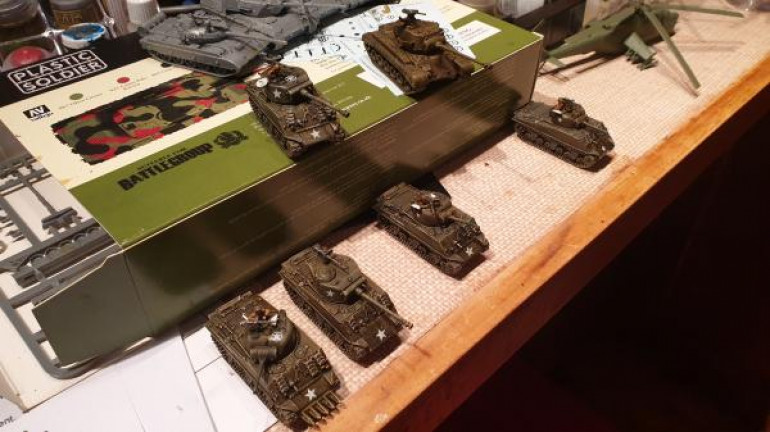 Tansk M314 Shermans Done couple of years back, just dabbing on Mirco sol to properly cure the decals.
Tansk M314 Shermans Done couple of years back, just dabbing on Mirco sol to properly cure the decals.At the Bootcamp I brought the stuffed British Starter Box so stuffed the box bulges, a box fairly popular over the weekend , even with Lloyd. which I will use to add to my partly finished troops of 11th Armoured Division, but as I put a dent in my Americans and Germans decided to finish both their armoured forces, and the 2nd platoon of 101st airborne. I’ve added a few items to the mix from e-bay so buy the time I’ve finished I will have 3 U.S armoured platoons of Shermans and a HQ plus a mixed unit of M10’s and M36’s and for really later war some Pershings, brought for a Tanks project started years ago.
Now have added decals to Americans, For those in Siberia or not watched the blogs from weekend I put a few of my shots of the the above on the OTT teams amazing tables.
































